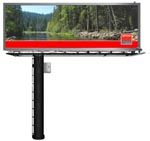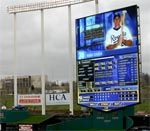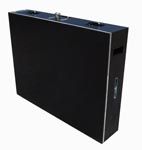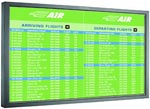From breakfast TV shows to daily newspapers and blogs, it seems everyone has an opinion on where the economy is going, and how quickly (or slowly) it will get there. The disparity of viewpoints is so wide that AV integrators and consultants-along with business owners from practically every other walk of life-are finding it harder than ever to plan ahead.
If there is one issue on which there is some agreement, however, it is this. There will be no return to cheap energy anytime soon. Or, indeed, ever.
Soaring gas prices are persuading millions of Americans to reassess the way they use their cars, and while casual rides are becoming increasingly discretionary, many are going a step farther and opting to use mass transit for some or all of their daily commute.
For the professional AV community, this has to be good news. Few contractors derived much benefit from the in-car gadgetry boom (mobile phones, GPS, DVD, and the like) that took place in the first half of this decade. Public transportation is a different ballgame. Where the installation of 5-inch LCD panels into individual family SUVs may not have fitted well into a typical pro-AV business model, a multi-station rollout of digital advertising screens might seem-if you'll pardon the pun-much closer to home.
Cleared For Takeoff
Transit locations such as airport terminals have been prime targets for the digital signage business almost since the term 'digital signage' was first coined. But it has taken a while for the conflicting demands of PIDS (Passenger Information Display Systems) to be reconciled satisfactorily with those of the advertising industry. As a rule, airport operators now seem to prefer advertising content to be delivered via systems that are entirely separate from flight information screens. This presents systems integrators with a dilemma: older terminals often do not have the space to accommodate additional screens, while newer ones tend to have higher levels of ambient light, reducing the number of viable display options.
The new Terminal 5 at London's Heathrow Airport shows what can be done. The terminal boasts no fewer than seven Lighthouse LED screens arranged in a landscape format of 14.08 meters by 3.36 meters. The screens, which have been installed for mobile communications company Nokia, are built into five ventilation towers that are dressed in blue glass. Landside passengers can view five screens (one on each tower), while those airside can see two screens, mounted on the rear of the second and third towers. The advertising content, managed by Beam Systems, promotes the airside Nokia flagship store.
"We had to use LED panels because there is so much natural light in Terminal 5," says Graham Wickman of 767 AV Consultants, which designed and specified the displays. "In addition, because of the screens being mounted on the ventilation towers, they had to be front-access and also had to meet very stringent weight criteria."
In common with the approach used in Nokia flagship stores worldwide, the five airside LED walls are fed with content formatted as if the screens were one unit, with a single large image spanning the entire width of the terminal's check-in area. This reflects a growing demand among end customers and their creative agencies for content that goes beyond the traditional confines of a 4:3 or 16:9 flat-screen display.
Going Up
And while most of us would rightly associate an airport check-in area with standing around for extended periods of time, not every transit location has such a static group of visitors. Underground train stations, for example, often have long escalators or other moving walkways which, in the past, have frustrated advertisers because of the minimal 'dwell time' of the audience. By replacing conventional paper billboards with LCD screens, venue owners can offer advertisers a medium that is much more visually compelling-effectively turning the side walls of an escalator into a dynamic image which alters as passengers travel up or down.
CBS Outdoor, the U.S.-based poster site operator, chose the London Underground for the first rollout of its so-called 'Digital Escalator Panels' last year, and reports excellent results. "London commuters are bombarded by advertising messages and therefore have high levels of ad avoidance," says Stephen Fuller, Head of Consumer Insight at CBS Outdoor. "However, our research demonstrates that this is not the case with Tube users. Not only do they welcome ads on the Tube, but in the case of the DEPs, they actually make journeys more pleasurable."
Relieving the monotony of a daily commute could be deemed as important a responsibility for AV content in transit locations as it is for radio stations in people's cars. You may have been charmed by a moving video image accompanying your journey below ground to the track, but what if you then have to wait an eternity for a train?
Emboldened by its success with DEPs and research findings that indicated two-thirds of users would like to see more digital advertising on the Tube, this month CBS Outdoor began rolling out another innovation: cross-track projection, or XTP for short. In complete contrast to the clean, airy spaces of modern airport terminals, the tunnels of the world's oldest underground passenger-carrying rail system represent a dark, dirty, and physically challenging environment for AV systems.
Charged with designing a suitable system by CBS Outdoor, Digital Projection came up with the XTP HD300-a new, high-brightness DLP projector that is protected to IP65 standards, making it the first projection device to be officially classified as waterproof and 100-percent sealed to the outside air.
"Tube tunnels are full of various materials and debris that have accumulated over the last 144 years, and which would destroy traditional air filters on precision display devices," explains Nick Cottiss, Digital Projection's international sales and marketing director. "Furthermore, the curvature of the tunnel wall meant that the projection screen had to be less than 4mm deep. The XTP HD300 has inherent geometry correction using advanced software calculations to precisely align the images to that curvature.
"We were honored to have been given the challenge to develop such a unique display. The benefits of digital advertising are limitless, and we are certain that the powerful and reliable XTP HD300 projectors will be a valuable asset to the communication offerings of CBS Outdoor."
As this edition of SCN went to press, CBS Outdoor had some 23 XTP screens and 830 DEPs on the Underground network, along with 181 large-format LCDs in station concourse areas. Significantly, though, the company expects to have more than 2,000 digital screens installed across the network by the end of 2008.
Tunnel Vision
In addition to the desire for customizable and easily modifiable content, another driver behind the growth of AV in transit applications is that it has reasonably green credentials. Video screens may consume power, but they are reckoned to be more environmentally friendly than the endless sheets of paper they replace.
One area of transit communications that has-until now-remained immune to the charms of AV is in-tunnel advertising. The first system of this kind was probably artist Bill Brand's 'Masstransiscope', a sequence of 228 hand-painted panels that was installed on the wall of the abandoned Myrtle Avenue station of the New York subway in 1980, and which was based on the principle of the 19th-century zoetrope.
Brand's installation has never been used to carry an advertising message, and more recent developments of the zoetrope theme have generally failed to capture the imagination of advertisers or their audiences. MetroVISTA, developed by Japanese-based Aap! Global in partnership with site operator JC Decaux, treats train passengers to an eight-second (or longer) motion-picture advertisement using nothing more sophisticated than a series of light-boxes mounted on the tunnel wall. Sensors attached to each box detect the speed and position of the train, and the boxes light up accordingly, but the system's reliance on paper means it fails to offer the flexibility that advertisers crave.
Enter Canadian-based Sidetrack Technologies, which began by offering strobe-based systems but now uses custom-designed LED strips to show dynamic content that can be served remotely to any location in the world from its Winnipeg headquarters-effectively bringing AV into the deepest, darkest tunnel. Again, London's Heathrow led the way when it installed a Sidetrack LED system inside the Heathrow Express tunnel at the start of this year. But two months ago, the Los Angeles Metro followed suit when it installed a similar system on its Red Line between Hollywood/Highland and Universal City stations.
Rob Walker, Sidetrack's President, describes the LED system as "the next narrowcast network, in which we can deliver our clients' messages to global, regional, local, or specifically targeted audiences among the millions of commuters using rail and subway transit worldwide".
And, for any cynics who doubt the growth potential of this market, it's worth knowing that in the same month that it launched its Sidetrack display system, LA Metro reported a six percent year-on-year growth in ridership, as commuters parked their cars and trucks, and took advantage of fares that are about one-fourth the cost of a gallon of a gas. Does your local installer of in-car GPS systems have a similar story to tell?
New Large Display Products 2008
- The Planar m52L joins the m-Series family of commercial-grade LCD displays suited for digital signage display applications in demanding public environments. The entire m-Series line offers advantages such as resistance to image quality degradation. Designed for use in tiled or stand-alone applications, the m52L features a narrow bezel. Features include intelligent backlight control, built-in tiling features (integrated Big Picture and mullion compensation), wide range of source compatibility and connectivity, and a standard VESA mounting pattern.
Mitsubishi Resolia
Mitsubishi's Resolia LED big-screen monitor is designed for indoor signage applications such as billboard advertising or informational displays in malls, airports, sports arenas, casinos, entertainment stages, and other public venues. Resolia is the only 140-inch LED screen with a pre-packaged design that is quick to install and simple to set-up. It is shipped in one piece but can also be broken down into a two-piece configuration for easier transport in tight spaces.

Barco DB-220, DB-320, DB-620
Barco offers three digital signage models, each purpose built for superior visual performance in all outdoor conditions. The DB-220 has a resolution of 160 x 336 pixels. The DB-320 has a resolution of 144 x 528 pixels. The DB-620 has a resolution of 208 x 720 pixels. Each has a 20mm pixel pitch, a calibrated brightness of 7,600 Nit, a 4,000:1 contrast ratio, field-replaceable smart shaders, and a lifetime of 100,000 hours. In addition, with each model, built-in intelligence monitors the LED color signature, temperature thresholds, and the sign's overall runtime.

Daktronics HD-X
Daktronics entered a new era of LED video with the HD-X series. Designed on a high-definition platform, the HD-X line features ultra-wide viewing angles, increased contrast with deeper blacks and more vibrant colors as well as world-class video processing for improved image quality. With its staggered pixel layout, the HD-X optimizes number of full-color pixels within a screen area and delivers true full-color lines and columns across the display. The HD-X series is available in either indoor or outdoor models.

Lighthouse Technologies LED Panels
Lighthouse Technologies' high-resolution R6-B and R4-S LED panels debuted with its latest LED display with the LEDScape Tile T120850, a high-resolution tile display designed for any size or shape. R6-B is a 6mm pixel pitch, black-faced panel. R4-S, meanwhile, is a standard version LED screen, designed for the indoor rental market. Finally, the LEDScape Tile T120850 is a new departure from Lighthouse's traditional LED display panels, combining the concept of LED technology and its applications to a diverse array of 'landscapes' to produce an innovative display solution for architectural projects.










